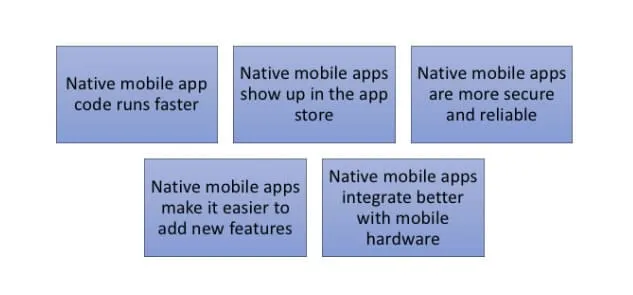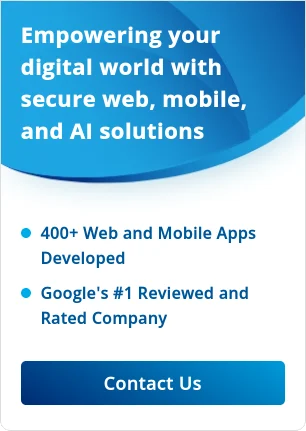
Overview of Native Development
The native application, a software program that is created for use on a specific stage or gadget. Since the native application is assembled for the use of a specific gadget and its OS, it has the capability to make use of the device-specific hardware and software. It gives enhanced execution and exploits the most recent innovation, for example, a GPS, in comparison to the web applications or versatile cloud applications created to be nonspecific over different frameworks.
Mobile App Platforms
Building native applications imply utilizing the local language of the stage, Objective-C on iOS, and Java on Android. The primary positive aspect of native applications is their execution and performance. Their apps are assembled and compiled into the machine code, which gives the best performance on the mobile phone.
The different forms:
| Native | Hybrid | Mobile Web | |
| Description | Completely specific to a given platform, such as iOS, Android, or Windows | Web-based content wrapped in a native container | All Web content, accessed via a browser |
| Best for: | Consumer apps requiring a high standard of UI/UX, or apps requiring complex device functionality | Content-heavy apps, especially those that can take advantage of pre-existing Web content, such as retail apps or e-readers | Responsive Web content that will be accessed on various hardware types |
| Stored on: | Device | Device | Server |
| Functionality | Can access all latest device features (as allowed by manufacturer) | Can access many device features | Cannot access device features |
| Audience | Limited to the audience for each operating system that you build it for | Can easily port to multiple operating systems for a wide audience | Can reach any device that has a browser |
| User experience (UX) | Premium UX | Decent UX can be attained with effort | Limited UX |
| Costs to build and maintain are relative* | Higher | Moderate | Lower |
Source:
*Relative to the other options given here, in most experiences, assuming you select the platform for its recommended use case, and assuming the developers have expertise in developing for that technology. This also assumes you are building the app for at least two app ecosystems (such as for both iOS and Android). Costs vary it depends on the complexity of the app.
User Experience: A major differentiator
It is a significant differentiator between native and hybrid apps. A native application is intended for a particular working framework. As an organization embarks on the task to build a new app, the user experience specific for that OS becomes of critical importance to the mobile presence on the market.
When undergoing hybrid app development, that application is platform agnostic. In hybrid app development, users can build it once and then can release it across multiple platforms. Firstly, the UI is simple in addition to that, users do not have to maintain two different code bases.
We are aware that the iPhone app is written in Objective-C or Swift while Android apps are written in Java, which is not transferable (that is, they are to be rewritten). Hence, hybrid apps are easier to build, take less time to market, and maintains one codebase.
However, the critical problem with the hybrid app is that even with a strong user experience design, it cannot truly build an app that caters to the dominant user types. Their style guidelines are too different between Android Apps and iOS Apps, hence when compared to native it must be weighed against all other strategic and tactical factors in order to make a decision.
Advantages of Native App Development
A native application is quick and more dependable as per the design. As the users explore and when navigating an app, the structure, and visual components are already on their phone, available for instant loading, and thereby providing a seamless experience. This is likened to downloading the majority of a site’s static content to a user’s phone without any delay which is then accessible for instant loading regardless of their phone’s internet speed.

Interestingly, a hybrid application has just a wrapper that is downloaded to a user’s mobile phone (which might possibly contain or may not contain all the navigational components) with the most of the information being loaded from the server.
Turning Weakness into Strength
There are people who believe that web apps are simply better due to their cross-platform nature. According to Dave (2018), the mobile platform market is split roughly 53/43 between Android and iOS in the United States.
It is said that with a native mobile app, either user needs to cut off half the potential market, or develop two separate source codes that are Apple and other for Android. None of them is good for projecting sales. As per sources, this is not completely accurate and thus there is a software developer called Xamarin. (For the detailed explanation refer to:
http://www.ascendle.com/blog/what-are-the-key-benefits-of-native-mobile-apps
One of the weaknesses is hence turned into a strength with native app development.
Why choose native over a hybrid?
Hybrid Apps are not so smooth and intuitive UX as native apps. Also, in case of weak internet connection, high load apps may take time to load and hence resulting in low performance. In addition, it increases battery consumption level for complex apps.
Considering the case of Facebook, when the company decided to migrate its mobile application from HTML5 to the native app was only due to the lower performance level. Hence, it can be said that there must be a significant level of difference in the performance level of hybrid and native apps. It was reported that Mark Zuckerberg felt it was a mistake for the company to choose HTML5 over native as 84% of users find performance to be an important aspect.
References:
https://www.linkedin.com/pulse/benefits-disadvantages-native-mobile-app-development-ios-josh-khan
https://ymedialabs.com/hybrid-vs-native-mobile-apps-the-answer-is-clear/
http://brookscanavesi.com/uncategorized/benefits-disadvantages-hybrid-mobile-applications/









